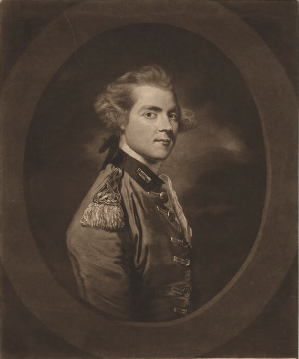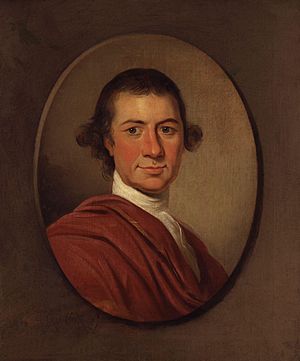Robert Fletcher (East India Company officer) facts for kids
Quick facts for kids
Sir
Robert Fletcher
MP
|
|
|---|---|

Sir Robert Fletcher c.1774-76
|
|
| Member of Parliament for Cricklade |
|
| In office 16 March 1768 – 1774 |
|
| Preceded by | Arnold Nesbitt Thomas Gore |
| Succeeded by | Arnold Nesbitt William Earle |
| Personal details | |
| Born | c.1738 |
| Died | 24 December 1776 Mauritius |
| Military service | |
| Allegiance | |
| Branch/service | Madras Army |
| Years of service | 1757-1776 |
| Rank | Brigadier general |
| Commands | Madras Army (1772-72 & 1775-76) |
Sir Robert Fletcher (around 1738 – 24 December 1776) was an important officer in the East India Company and a Member of Parliament (MP) for Cricklade. He started his career with the East India Company in 1757 as a junior clerk. However, he soon moved to their army.
Even though he was dismissed twice from the army, he was always brought back. Sir Robert was even knighted for being brave in battle. He rose through the ranks to become a high-ranking officer. After his military service, he became a Member of Parliament. He later returned to India to lead the Madras Army.
Contents
Robert Fletcher's Early Life and Career
Robert Fletcher was born around 1738. His parents were Robert and Elizabeth Fletcher. When he was young, his father was a major in the Jacobite Army. This was during a time of rebellion in 1745. After the rebellion failed, his father had to leave Scotland. He returned in 1754.
In May 1757, young Robert Fletcher started working for the East India Company in Madras, India. He began as a "writer," which was a junior clerk. In September, he joined the company's army as an ensign, a low-ranking officer. He was quickly promoted to lieutenant.
Fletcher was once dismissed from the army for being disrespectful. But a senior officer, Eyre Coote, helped him get his job back. Fletcher fought in the Seven Years' War, a big global conflict. He became a captain in 1760.
He returned to England in 1763 and was knighted on December 29. This honor was given to him for his bravery in battle. He continued to be promoted, becoming a major in 1764 and a lieutenant-colonel in 1765. He went back to India to lead a group of soldiers. He was involved in a soldier's protest in 1766. Because of this, he was dismissed from the army again by Robert Clive. After this, he returned to England.
Robert Fletcher's Political Career
When Fletcher came back to England, he wanted to become a Member of Parliament (MP). He first thought about running in Bridport. Then, in the 1768 British general election, he ran for two seats in Malmesbury. He and another candidate, William Mayne, only got two votes each.
Not giving up, Fletcher visited Cricklade, Wiltshire, just before their election. He found out that a relative of Robert Clive had decided not to run there. So, on March 16, 1768, Fletcher won a seat in Cricklade without spending any money upfront. However, it's believed he later promised to pay £4,000 to the voters. The other seat in Cricklade went to George Damer.
In Parliament, Fletcher usually voted against the government led by William Pitt. His main goal was to get his job back with the East India Company. He had tried earlier that year but failed. Another MP, George Grenville, spoke to Clive on Fletcher's behalf. Clive then dropped his objections. On December 15, 1769, Fletcher was given his job back and promoted to colonel. Even though he was officially sent to Madras, he didn't sail until 1771. During this time, he started to support the government in Parliament.
First Return to India
When Fletcher arrived in India in 1772, he took command of the Madras Army. This was a military force of the East India Company. Within a few months, Fletcher had disagreements with the governor of Madras, Josias Du Pre. This conflict became very serious in January 1773. Du Pre removed Fletcher from the council, which was a group of advisors. He also ordered Fletcher to go to Trichinopoly to keep him away from the main city.
In March 1773, Fletcher decided to leave India. Around this time, he wrote to his friends in England. He asked them to try and get him appointed as the Commander-in-Chief of all British forces in India. However, this effort was not successful.
Fletcher took part in parliamentary work in 1774. He voted against making a law about parliamentary elections permanent. On February 28, he told the House of Commons that he wanted an investigation into the East India Company's business. After this, the Company hired him again. They promoted him to brigadier-general in April 1774 and sent him back to Madras. Fletcher delayed his trip to run for election in Cricklade again in the 1774 British general election. But he withdrew his name the day before the vote. He married Anne Pybus, a banker's daughter, on December 17, 1774.
Second Return to India
Fletcher arrived back in Madras in June 1775. Soon after, he had disagreements with the new governor, Lord Pigot. In October 1775, Fletcher once again became the Commander of the Madras Army. This position also gave him a seat on the council of the Madras Presidency.
Fletcher was part of the group on the council that disagreed with Lord Pigot. Pigot then removed the people who opposed him and took control of Fort St. George. Because of this, Fletcher and others arrested Pigot. At this time, Fletcher was sick with tuberculosis, a serious lung illness.
In October 1776, Fletcher left India on a ship called the Greenwich. He hoped the sea journey would help him get better. However, he died in Mauritius on December 24 during his travels. In April 1777, King George III, who didn't know Fletcher had died, wrote about him. The King said, "Sir Robert Fletcher appears with his usual inclination to disputes" regarding the conflict with Pigot. Fletcher left behind a large amount of money and valuable items, including many pearls.


